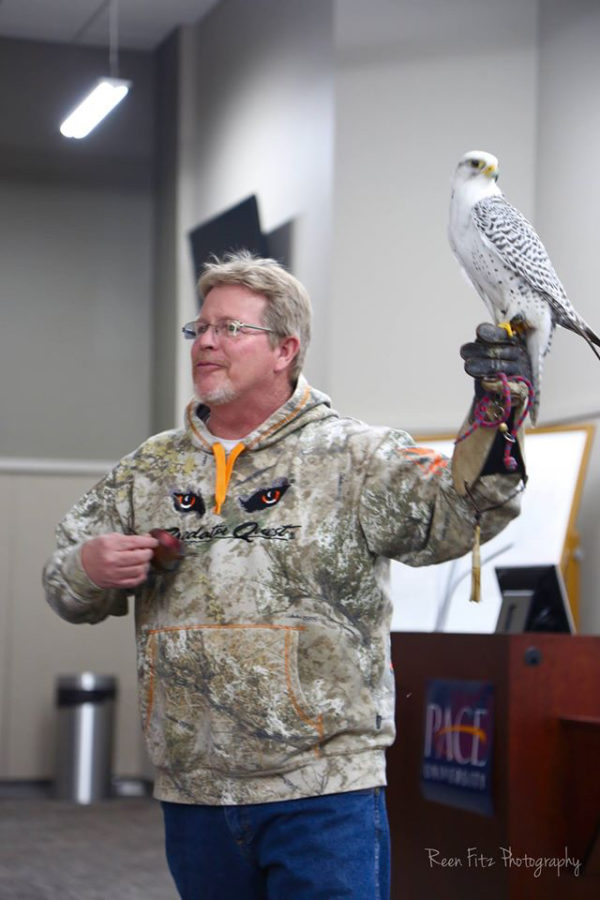James Eyring’s Food for Thought
James Eyring’s dyslexia made academics difficult growing up, but the bird feeder that hung outside his kitchen window made him the naturalist he is today.
Eyring, Pace’s Nature Center’s assistant director, would watch a plethora of birds that flew into a black bird feeder, which hung a foot outside his six-over-six pane kitchen window while looking at pictures of them in a 1934 leather-bound copy of the Audubon Field Guide to the Birds that sat right next to the sugar on the kitchen table.
He couldn’t read at an efficient level because of his dyslexia, so he would just look at the pictures while his mother or father would point out which bird was which. It sparked his inner naturalist at seven-years-old.
“That bird feeder is probably as instrumental as anything in making me who and what I am today because it was something I enjoyed—the birds coming to the feeder—and learning about the birds,” said Eyring, who graduated from SUNY Morrisville in 1979. “Birds have been a mainstay in my life. They’ve been kind of my totem for as long as I can really remember.”
Birds and nature became a totem because he wasn’t a gifted student, but Eyring was always looking at any nature-related books despite this impediment.
The inability to differentiate 15 from 51 but effortlessly identify birds such as a male downy woodpecker by the length of its beak or the red patch on the back of its neck perplexed his parents and often frustrated his father, Allan, especially.
Allan Eyring, a harsh-voiced NYC firefighter, played as much of a role as the bird feeder did in precipitating Eyring’s passion for birds and nature, however.
If it were not for his father, the 5-foot-8-inch naturalist would have never been thrust into rural North Salem, NY or discover his chance to falcon birds of prey.
He came across a red-tailed hawk one day when he was younger with jesses—leather straps signifying ownership—around its ankles, used a retrieving dummy from his father’s basement, and tried to catch the falcon. He failed, but discovered a man named Paul Kupchok, who was in a town five miles away, was the falconer.
Kupchok wasn’t willing to sponsor Eyring, however, which is required to become a falconer in New York.
“He wasn’t willing to do that, well he was, but he wasn’t willing to do it unless I really hounded him, and I did,” said Eyring, who Pace hired in 1980. “He was my sponsor for my two-year apprenticeship and from there I became a general falconer after I guess three or four people wrote letters saying I was doing good things, I was educating people. Years later, I became a master falconer.”
Eyring mastered how to falcon and much like the bird feeder taught him, Eyring—like any naturalist—wanted to teach and share this with everyone.
The Nature Center never considered animals like the birds of prey before Eyring was hired, according to the Nature Center’s Director Angelo Spillo, because no one could handle them. Eyring’s expertise of falconry and wanton to share and teach about nature brought the Birds of Prey program to Pace in 1981.
“I always say in [my] class that [Eyring’s] a true naturalist because what he does for work he does on his free time,” said Spillo, who’s worked with Eyring for 35-plus years. “The animals are as close to his children as they can be. On the weekend, doesn’t matter. On Christmas day, doesn’t matter. Jim comes in to [take care of the animals].”
The Birds of Prey program wasn’t just a way for Eyring to share his passion with the university, but it was also used—and still is—as a recruiting tool that both Eyring and Spillo see invaluable.
Eyring’s childhood bird feeder is in his possession today, but he doesn’t use it because it’s slightly damaged. He does, however, use bird feeders at home and at Pace to teach his five-year-old daughter, Layla, and students about birds, respectively.
“Being a naturalist, I’m constantly learning new things, I’m constantly putting new things in the data bank because I’ll never know it all,” Eyring said. “People say [to me], ‘when are you going to retire, you’ve been here forever,’ and I’m like, ‘I’ve got another 35 years in me.’ I’m nowhere near done yet.”
Your donation supports independent, student-run journalism at Pace University. Support the Pace Chronicle to help cover publishing costs.

